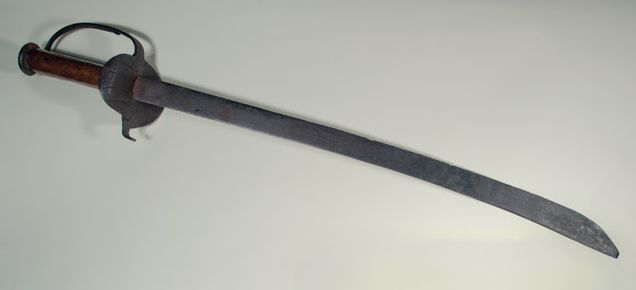Cutlass [hangar or cutlass belonging to Col. Benjamin Church and believed to be the sword Church was wearing when King Philip was slain]

Cindy Chen, Hongyang Zhao and Jack Hemphill
Our work puts primary emphasis on the historical significance of Benjamin Church’s cutlass and his active participation in the King Philip’s War. The paper is intended to help attain a refined understanding of Benjamin Church as the forefather of the army branch Ranger and of the artifact that he passed on down his bloodline. To help us delve into Church’s relationship with the cutlass, we have devised several topics that will be addressed in our paper: introduction to Benjamin Church’s cutlass, the weapons of the seventeenth century, introduction to Benjamin Church and his role in the King Philip’s War, Church’s military background, how the cutlass was useful in Benjamin Church’s life, taking a look into the types of popular weapons colonists used on a day-to-day basis, where the cutlass was passed onto after Church’s death, and the current whereabout of the cutlass.
The cutlass sword defined by the Oxford English Dictionary, “Is a short sword with a flat wide slightly curved blade, adapted more for cutting than for thrusting.” Church’s cutlass was crafted from 73.4 cm long steel with a maple grip measuring 13 cm. The grip of Church’s cutlass is crafted from maple and resembles the exact cutlasses that are carried by buccaneers in the Caribbean. It was curved and very much resembled a naval cutlass. The cutlass was designed for hand-to-hand combat during the Indian wars. Settlers used the cutlass as a tool, to be able to hew and carve up the ground for farming.
Colonists were heavily armed in the 17th century. Weaponry was the only form of technological defence, and there were many elements Colonists would have to face on a day to day basis. Weapons were critical to have on hand to be able to hunt for food and for protection from wild beasts or enemies. Major weapons of the 17th century include the musket, a plethora of types of knives and swords, and of course the cutlass sword that Benjamin Church carried with him during King Philips’ War and other events.
When the war broke out in June 1675, Benjamin Church volunteered to become an officer in the joint force of colonists and their Indian allies. Unlike his peers who only familiarize themselves with tactics that worked in open space, Church excelled at emulating Indian tactics that were effective in forest areas, dividing his force into smaller fighting groups, which were suitable for guerrilla warfares. His strategies proved to be successful when one of his Indian soldiers spotted Metacom and shot him on sight. Church was then recognized as the first ranger in the US for his unparalleled achievement in quelling the rebellion.
Church’s father was a sergeant during the Pequot war of the 1630s. Although technically more of a militia at the time, in 1676 Church created what would be the first special operation ranger force in American history. Unlike many of the Puritans, Church was close to the Native-Americans and adopted some aspects of their lifestyle to help him and his people on the frontier. He realized that fighting in the traditional English way by everyone clumping together and shooting was significantly less effective than the native American style of spreading out and acting more stealthy. It was first frowned upon by the English to adopt this style, after noticing its success against the Wampanoags, Narragansetts, and Nipmucks, they agreed it was more effective. He led a special unit that fought against the Native Americans by using their own tactics. Like the Native American forces, Church and his men wore moccasins, used concealments, and ambush techniques. In August 1676 Church’s rangers, which included Englishmen and Native Americans, defeated King Philip’s forces and beheaded him, ending King Philip’s War. Church also later became involved in King William’s War and Queen Anne’s War in similar roles. He was eventually commissioned as a Colonel and is revered for his attack philosophies that included: meticulously planning each operation, making sure his soldiers are properly trained, fed, and equipped, making alliances with potential allies, not inflicting unnecessary harm, use of stealth attacks, leading by example from the front, and maintaining communication with everyone.
After Benjamin Church’s death in 1718, the cutlass was inherited by his son, Thomas Church. Then the cutlass was passed to Thomas Church’s daughter, Mercy Church Richmond, who kept the cutlass by her bed during the revolutionary war. Later her daughter, Anne Richmond Antwood donated the cutlass to the Massachusetts Historical Society, which is in possession of the cutlass up to this day.